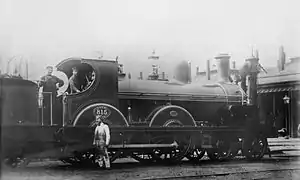| L&YR Barton Wright 4-4-0 | |||||||||||||||||
|---|---|---|---|---|---|---|---|---|---|---|---|---|---|---|---|---|---|
 L&YR 815 built by Neilson in 1883 | |||||||||||||||||
| |||||||||||||||||
| |||||||||||||||||
| |||||||||||||||||
| |||||||||||||||||
| Notes:[lower-alpha 4][2] | |||||||||||||||||
The Lancashire and Yorkshire Railway (L&YR) Barton Wright 4-4-0 was four-coupled eight-wheeled bogie express engine which entered service in 1880.
Design and construction
Locomotive superintendent William Barton Wright ordered the first eight of the type in 1879 from Sharp Stewart and Company for the Hellifield−Chatburn line.[3]
Sharp Stewart supplied a further 16 in 1881 with Neilson and Company supplying 20 in 1883 and 10 in 1884, the latter having Joy valve gears.[4] The final batches Barton Wright batches went back to link motion: 20 from Kitson and Company in 1885 and 20 from Vulcan Foundry up to 1886.[4] Following Barton Wright's resignation and John Aspinall's appointment, the final 16 ordered from Vulcan Foundry delivered in 1887 had 4-inch longer wheelbases between the driving wheels, Timmis springs on the eight axles, and bogie wheels reduced to 3 feet 0 inches (0.91 m) permitting straight main frames and a horizontal grate.[5]
Subsequent developments based on the design were the Aspinall L&YR Class 2, of which 30 were ordered from Beyer, Peacock and Company with Joy valve gears and 160 psi boilers, as well as other variations, and the L&YR Class 3 with 7 feet 3 inches (2.21 m) driving wheels.[6]
Service
The 6 feet 0 inches (1.83 m) driving wheels were suited to more challenging routes but on a non arduous route the Ramsbottom 2-4-0s could be faster.[7] Smaller tenders were initially necessary until bigger turntables were installed.[7]
Most were withdrawn in the early 1900s with only two, Nos. 922 and 924 going past 1914 to be classified Class 2 by Hughes in 1919. These passed through amalgamation into the LNWR, and finally becoming London, Midland and Scottish Railway (LMS) Nos. 10100 and 10101 respectively before withdrawal in November 1930.[8]
1887 Royal Jubilee Exhibition
One of the final Vulcan Foundry batch with 3 ft bogie wheels batch was exhibited at the Royal Jubilee Exhibition, Manchester 1887.[9][10]
Notes
References
- ↑ Bulleid (1967), p. 103.
- ↑ Marshall (1972), p. 93,238–240.
- ↑ Marshall (1972), p. 92−93.
- 1 2 Marshall (1972), p. 93−94.
- ↑ Marshall (1972), p. 94.
- ↑ Marshall (1972), pp. 129, 131, 137–138.
- 1 2 Marshall (1972), p. 93.
- ↑ Marshall (1972), pp. 238–240, 273.
- ↑ Bulleid (1967), p. 94.
- ↑ "Royal Jubilee Exhibition, Manchester 1887 : official catalogue". P 150/640 Lancashire and Yorkshire Railway Co., Hunts Bank, Manchester.
Bibliography
- Bulleid, H.A.V. (1967). The Aspinall Era. Ian Allan Ltd.
- Marshall, John (1972). The Lancashire & Yorkshire Railway, volume 3. Newton Abbot: David & Charles. ISBN 0-7153-5320-9.